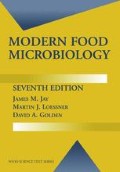The use of high temperatures to preserve food is based on their destructive effects on microorganisms. By high temperatures are meant any and all temperatures above ambient. With respect to food preservation, there are two temperature categories in common use: pasteurization and sterilization. Pasteurization by use of heat implies either the destruction of all disease-producing organisms (e.g., pasteurization of milk) or the destruction or reduction in the number of spoilage organisms in certain foods, as in the pasteurization of vinegar. The pasteurization of milk is achieved by heating at one of the following time/temperature combinations:
Access this chapter
Tax calculation will be finalised at checkout
Purchases are for personal use only
Preview
Unable to display preview. Download preview PDF.
Rights and permissions
Copyright information
© 2005 Springer Science+Business Media, Inc
About this chapter
Cite this chapter
(2005). Food Protection with High Temperatures, and Characteristics of Thermophilic Microorganisms. In: Modern Food Microbiology. Food Science Text Series. Springer, Boston, MA. https://doi.org/10.1007/0-387-23413-6_17
Download citation
DOI: https://doi.org/10.1007/0-387-23413-6_17
Publisher Name: Springer, Boston, MA
Print ISBN: 978-0-387-23180-8
Online ISBN: 978-0-387-23413-7
eBook Packages: Chemistry and Materials ScienceChemistry and Material Science (R0)

